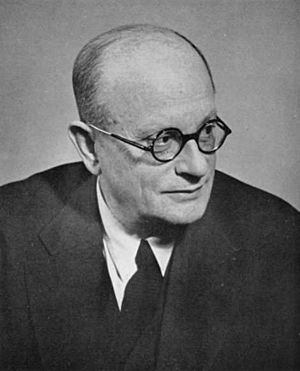Francis Simon facts for kids
Quick facts for kids
Sir Francis Simon
|
|
|---|---|
 |
|
| Born |
Franz Eugen Simon
2 July 1893 |
| Died | 31 October 1956 (aged 63) Oxford, UK
|
| Nationality | German-British |
| Alma mater | University of Berlin |
| Known for | Uranium-235 |
| Awards |
|
| Scientific career | |
| Fields | Physicist |
| Institutions | University of Oxford |
| Doctoral advisor | Walther Nernst |
| Doctoral students | Kurt Mendelssohn Brebis Bleaney |
| Notes | |
|
He is the first cousin of Kurt Mendelssohn.
|
|
Sir Francis Simon CBE (born July 2, 1893 – died October 31, 1956) was an important German and later British scientist. He was a physicist and chemist who made a big discovery. He figured out a way to separate a special type of uranium called Uranium-235. This method was very important for creating the first atomic bomb.
Contents
Early Life and Studies
Franz Eugen Simon was born in Berlin, Germany, on July 2, 1893. His family was Jewish. During World War I, he showed great bravery and was awarded the Iron Cross First Class.
He studied at the University of Berlin. There, he earned his doctoral degree. He worked with a famous scientist named Walther Nernst. Their research focused on physics at very cold temperatures. This work helped explain the Third law of thermodynamics, sometimes called the Nernst-Simon Heat Theorem. In 1931, he became a professor at the University of Breslau.
Moving to England
In the 1930s, a political group called the Nazis came to power in Germany. They were against Jewish people. Because of this, Franz and his wife decided they needed to leave Germany.
A British scientist, Frederick Lindemann, 1st Viscount Cherwell, met Franz in 1933. He invited Franz to join the Clarendon Laboratory at the University of Oxford in England. Franz was also offered money for his research.
When Franz resigned from his job, officials tried to stop him and his wife from leaving. Franz bravely threw his Iron Cross medals onto a table. For unknown reasons, their passports were returned later. With help, Franz was able to bring his important research equipment with him. His wife and children followed him to England two months later. Once in the UK, he started using the English name "Francis."
Important Work in England
Using the equipment he brought from Germany, Francis Simon did amazing work in low-temperature physics. In 1936, he was the first to create liquid helium using a special cooling method.
His job in Oxford became more secure in 1936. He was appointed a Reader in Thermodynamics and a Student of Christ Church.
During World War II, because he was born in Germany, he was not allowed to work on radar until 1940. The Nazis also targeted him, so his wife and children moved to Canada for safety. Francis stayed in Oxford.
In 1940, he worked with other scientists to study how to separate Uranium-235. This was a very difficult task. He even used his wife's kitchen strainer to help with early experiments! Later, he used a special filter with tiny holes. His findings on separating uranium were crucial. This work became the basis for the process used in the Manhattan Project. This project successfully produced enough Uranium-235 to create the atomic bomb. After the war, he returned to Oxford to continue his low-temperature research.
In 1945, he became a professor at the University of Oxford. He also became the head of the Clarendon Laboratory in 1956, shortly before he passed away.
Family Life
Francis Simon married Charlotte Münchhausen in 1922. They had two daughters, Kathrin and Dorothee.
Honours and Awards
Sir Francis Simon received many awards for his important scientific work:
- Fellow of the Royal Society, 1941
- CBE, 1946
- Rumford Medal of the Royal Society, 1948
- Knighted by the Queen, 1954

